As a holiday and end of year gift, I have finished up Part II of the colonial currency and gold coin rant with all due haste. I’ve got three Dominions to cover here, so it’s a bit long. Take a break after the Raj and have a festive drink or something.
Remember that handy reference guide to predecimalization system of British coinage I shared in the previous post? Well, remember it fondly, as things are about to go a bit funny in the other colonies. The general rules of how coins work holds for the rest of Britain’s colonies, but you may notice some significant differences from the American experience. TL;DR version: I think Britain never really liked America.
The Jewel In The Crown: the East India Company (EIC) and the British Raj
Let’s start with the fact that the EIC and direct rule of India by the the British Crown, the Raj, are different entities. The Raj replaced the EIC after the company was nationalized in the wake of the First War of Indian Independence in 1858 (AKA the Sepoy Rebellion, for those of us who had a more Anglocentric education). While the Raj wasn’t necessarily pretty, it was nicer than the 250 years of company rule that preceded it.
The East India Company was organized in 1600, which puts it about the same vintage as the Charter of the Virginia Company of London that founded Jamestown and they shared some corporate officers. Unlike the CVC, the EIC didn’t go bankrupt, collapse, and revert to the Crown within two decades. Part of the reason for this was a vested government interest in cracking open the tea & spice trade routes to India and the islands of the Indonesian Archipelago, prying them away from the Portuguese and Dutch who were already there obliterating the over 3000 year old Indian Ocean & Silk Road trade networks.
{HOLIDAY ASIDE: for timely history related to the colonial war games, nutmeg was so important that the Dutch were willing to cede New Amsterdam to the British in exchange for remainder of the Banda Islands the spice originated on to secure a nutmeg monopoly in the Treaty of Breda, concluding the Second Anglo-Dutch War. Really, this was everyone admitting the truth on the ground as each colonial power had effectively kicked the other out of these territories. Go enjoy some egg nog or a coquito.}
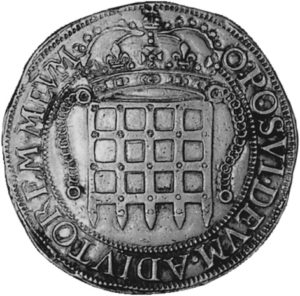
Of course, this calls for a new coin. In January 1601, a large silver coin, larger than anything that circulated in England was commissioned called the 8 testern, AKA the Portcullis coins because of the motif on the reverse. What is a testern? Theoretically, one testern was a sixpence, the two testern would’ve been a shilling, which meant the 8 testern was 4 shillings…WHICH EQUATED TO NO OTHER COIN. Five shillings is a half crown, not four. The broken denomination pattern is infuriating but expecting reasonable behavior out of the British government is rank foolishness. Speaking of foolishness, here is a link to a modern reissue of the testern from the extremely tasteless modern luxury brand incarnation of the EIC. Seriously, of all the brands to resurrect I’m having a hard time thinking of one more blood soaked and odius, except maybe the British African Company or the International Association of the Congo.
But why? Remember those Spanish 8 reales coins the Americans are using to the annoyance of their colonial overlords? Well, they’re over here in India too and they’re the standard for silver exchange. The 8 testern was minted with a weight and purity to be comparable with the 8 reales, except with the QE1 on it to make it good and respectable money. To the disappointment of the EIC, the merchants of Bombay & Calcutta gave precisely zero shits about the royal seal on the coin, they just wanted the silver for weight and pointed out, like a patronizing parent, “You guys do know that we do most of our commerce in gold, right? India is fabulously wealthy and you came with Poor People Money.” But it was good enough to establish trading post footholds and the return trips to England with goods made sure the EIC never had to worry about having gold to trade again.
And so, of all the British colonies, for cultural requirements and the sheer amount of gold washing around, they were the first to get gold coins locally minted. I can’t say it was with the blessing of the Crown, but rather as an act of expediency by the EIC to mint it locally in each of the presidencies (independently operated regions that franchisees of the EIC had bought or shot their way into control of). This was for their own needs, meaning there were a lot of mints and thus a lot of different coin patterns and denominations. The ulterior motive of transforming foreign coins into good and proper ones factored into it but, as the EIC was in it for the profit, they worked with locally familiar denominations to facilitate trade. Familiar coins like the rupee are there, but also the anna, mohur, fanam, pagoda, and strange to anglophone ears, the cash. I tried to build a conversion chart from these to the £/s/d system and my brain just gave up. As a physicist, unit conversion is supposed to be a bedrock skill and I just can’t do it. I am ashamed.
Once the reorganization happened in 1858 for direct rule by the Crown, one uniform monetary system was established for the Raj, with the gold rupee at the top of it. Please note, at no point was it questioned that gold coinage would be used and minted in country under either the EIC or the Raj.
The Great White North: The Canadas
At about the same time Britain was trying to kick the Dutch and Portuguese out of India for spices, they were doing about the same to the French in North America to wrestle the fur trade and fishing rights away. Canada, as we know it today, didn’t exist until 1949 when Newfoundland and Labrador finally joined the confederation and, as a whole, Canada didn’t get full sovereignty until 1982. Speaking as a frustrated geologist, dominions and provinces slowly accreted onto The Canadas until it looks like it does today, kinda like the geology that assembled the land itself. The big difference is that the North American craton doesn’t speak French, unlike the people on top of it who very much shaped the colonial experience. Imagine if the 13 American colonies were regularly invading & murdering each other, mostly using local Native American tribes as proxies, rather than somewhat ignoring each other and instead spending their time murdering their local tribes. That’s the difference between Canada and America.
The French had a somewhat enlightened point of view toward money in all their colonies. As the first settlers in the region, with their network of farmers & voyageurs canoeing hither and yon, the deal went like this: bring us furs, and we will pay you in the same currency we use at home. Of course, sous from La France weren’t terribly helpful out in the beaver ravaged lands of the Quebecois frontier, so the trappers preferred to take trade in kind and, of course, blow their cash in the big city of Montreal (pop. ~1000). The local tribes that the French had established good relations with didn’t particularly care about coins either, preferring to receive good steel, gunpowder and muskets instead.
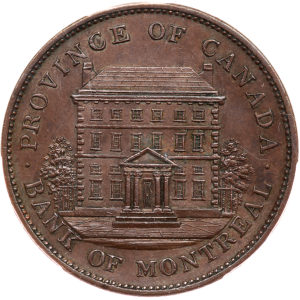
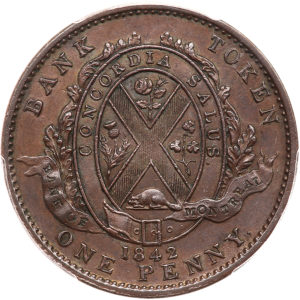
But to fast forward a bit through a lot of killing, Canada had a monetary & economy problem much like colonial America did. Like many countries before them and after, the answer was to make proxy currency. The various merchants and banks started making tokens that were effectively business cards, but also because the metal and size were right, would get used as pennies. Keeping in mind that Canada wasn’t quite Canada until at least the early 20th Century, the colonies/provinces were each figuring out their own proxy money to maintain internal economy while they were separated from the larger confederation. But, really, when you get down to it, it all comes to the Hudson Bay Company being happy to maintain debt ledger tables in the background of what looks like a pure barter system. They were the broker of good faith that let the fur to blankets and trinkets trade happen as if money was unnecessary. Of all the original Crown chartered colonial companies from the 17th century, the Hudson Bay Company is still kicking around and you may not be remotely surprised about how much they still own in the 21st century.
Once the Acts of Confederation went through and the Dominion of the Canada was established, they got their own currency and they decided to go with a decimalized system like the United States. As I mentioned in the previous post, they were already used to thalers, so dollars made sense. What Canada DID NOT get was permission to mint gold. For reasons I haven’t quite found the answer to, Newfoundland, who didn’t join the confederation, was permitted to have $2 gold coins during Queen Victoria’s reign. The $2 coin also was struck with a value of “200 cents/100 pence” as an early attempt at bridging the conversion to from the £/s/d system to decimalized in one coin.
And then the Klondike Gold Rush happened.
It was felt that processing the proceeds of the Canadian side of the Klondike Gold Rush into local currency might imbalance the Dominion/Home Country power relationship. Having already lost one major colony on the North American continent over issues of money and taxation, they weren’t up for a second. Canada didn’t get permission mint gold coins of their own until 1912 out of paranoia, despite all the gold coming out of the Klondike. But after two years brief years of making the $5 gold coin, Canada had to quit in minting it in 1914 because all that gold was needed to pay for war preparations as World War I broke out. Vimy Ridge wasn’t gonna pay for itself and mere blood wasn’t going to be enough to cover the tab. Much like Gallipoli taught Australia and New Zealand they weren’t just “British but far away”, Vimy taught that to Canada.
Captain Bligh’s Bounty: Australia & New Zealand
Okay, once again, we’re over 1500 words in and I haven’t had a poop joke yet. So let’s jump directly into DUMP COINS. HURHURHUR, dump.
Australia had a bad case of being very far away from Ol’ Blighty, which means the logistics of getting the money all the way there was hard. Considering that Australia was a series of penal colonies, how much effort do think they were willing to expend? Right, zero, go find some rancid whale blubber to chew on, transportee. Of course, even in Australia, an economy did develop, even if it was sheep and blue gum based at first and the sheep isn’t the best medium of exchange (NOTE: the traditional Irish denominations of sheep/cow/wife based currency will disagree with me here). So, the lazy answer was to go grab the nearest convenient money and re-mint it into proper British coin. Now, would you like to melt down and restrike these coins? Goodness no! Did you forget we’re colonial strivers from Mother England (AKA the Sterling), being lazy out in the colonies “running the place” lest the native born prisoners’ children think they’re in charge?
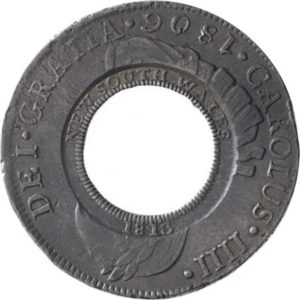
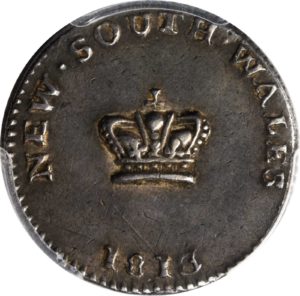
No, the answer was to take an 8 reales coin, punch the center out of it (AKA “the dump”) to strike a new coin out of that, value of 1 shilling and threepence, and do that again to the remaining ring as well (AKA “the Holey Dollar”) with a value of 5 shillings. Because why make things easy? I should note that this creative answer, which Governor Macquarie authorized, was carried out by a convict who had been transported for the crime of forgery. Australia similarly used merchant tokens as proxy currency in the absence of the real stuff. I’m to understand that one mid-19th century Tasmanian draper’s token circulated as a penny well into the 20th. That’s effectively deciding that your dry cleaning claim ticket is good enough to function as money.
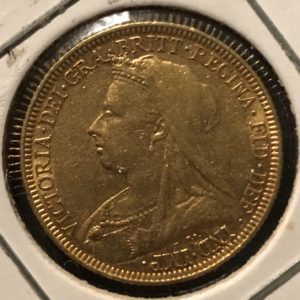
A bit later, there were several gold rushes which made Australia even more worthwhile to Mother England, except the same very, very far away problem reared it’s head again. It was decided that the prudent course of action was to mint all this bullion into sovereigns before shipping it to the other side of the globe. If you were going to engage in piracy to steal this gold, you were going to have to exert effort to change it into your own coinage. Melbourne, Perth, and Sydney all got to have mints to handle the flux of gold, but little of it actually stayed in Australia.
Meanwhile, in New Zealand, they had the structural benefit of not being settled by convicts, but they were even less convenient than Australia. They got the full suite of non-gold British coinage minted for them, just not often. To the New Zealanders reading this, please don’t take this as an insult, but your country is a cultural backwater, much like Alaska and New Hampshire (NH is a goddamn numismatic oddity, I tell you what). As this is a hydrological metaphor, what it means is that things brought to New Zealand somehow don’t leave. Coins that circulated throughout the British Empire just kinda…stopped…when they got to New Zealand and after that only circulated within the islands. What gold coins New Zealand received were all minted in Australia.
Then New Zealand had a gold rush of their own on the South Island. And so, the mint Dunedin was set up to make the largest gold coin the world has ever seen, the Golden Moa, and… sorry, no, I’m lying. Because the Crown had already solved the remote gold rush problem with mints in Australia, all of New Zealand’s gold was shipped to Australia for minting. Australia already had enough sheep, so New Zealand got to keep those.
WHAT ABOUT ALL THE OTHER COLONIES, PHIL?
Frankly, these were the ones that merited special treatment. Hong Kong was odd in that it had dollars rather than the normal British system or a hybrid with the local traditional coinage. They tried a hybrid for one year before selling the entire mint to the Japanese as their coins didn’t impress the Chinese merchants in Shanghai at all. Shanghai was already used to the 8 reales, they were already minting dollars for Canada, so why not do it for Hong Kong too?
South Africa, for the early years, didn’t get any special coins of their own because they were on the way back and forth to India and Australia. The challenge for Cape Town was exchanging back and forth between all the different, but equally valid, coins of the British Empire washing through their port. For the west and east African colonies, the authorities followed the British currency model pretty strictly, with the exception of the guinea entering circulation from the British African Company (BAC) which had taken control of the gold fields of Ghana. The location of the former BAC headquarters in London is what gives the Elephant & Castle underground station it’s name, as the corporate heraldry (and the early guinea coins) featured an elephant and castle.
The Caribbean, as the sugar part of the triangular trade, never had much call to develop an independent economy that deserved its own coinage independent of Britain’s. “Molasses to Rum to Slaves” as the song goes, not much room for coins in that.